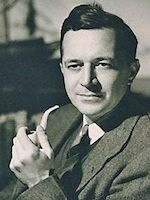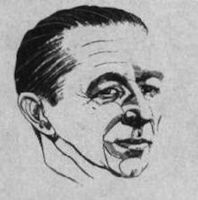| Murray Leinster: Science Fiction Technology and Ideas |
| Murray Leinster (b. 1896 - d. 1975) was the nom de plume of William Fitzgerald Jenkins, born in Norfolk, VA. He served in WWI in the Army, also serving in WWII in the Office of War Information. His science fiction output was voluminous, starting in 1919 and continuing until 1970; he used the Leinster name almost exclusively for sf writing (except of course for A Logic Named Joe, which he wrote under the name Will F. Jenkins).

 (Murray Leinster) He won a 1956 Hugo for Exploration Team and a retro-Hugo in 1996 for First Contact. |
| Invention/Technology | Source Work (Publication Date) |
|
Air Tank Flying |
The Power Planet (1931) |
|
Carson Circuit - the secret of the Internet |
A Logic Named Joe (1946) |
|
Caterwheel |
Sand Doom (1955) |
|
Cosmoquake |
Things Pass By (1945) |
|
Dark Side |
The Power Planet (1931) |
|
Dimensoscope - see into new dimensions |
The Fifth-Dimension Catapult (1931) |
|
Disposal-Safe |
Exploration Team (1956) |
|
Eagle With Camera |
Exploration Team (1956) |
|
Escapecraft |
The Ethical Equations (1945) |
|
First Contact |
Proxima Centauri (1935) |
|
Foot Loops |
The Power Planet (1931) |
|
Garbage Screen - chaff in space |
Space Tug (1953) |
|
Gravity-Simulator Harness - maintain muscle and bone in space |
Space Tug (1953) |
|
Heat-Suit |
Sand Doom (1955) |
|
Hide in the Asteroids |
Plague (1944) |
|
Inflatable Air Lock - very early reference |
Space Tug (1953) |
|
Landing-Grid |
Sand Doom (1955) |
|
Living Space Ship |
Proxima Centauri (1935) |
|
Logics - early home computer |
A Logic Named Joe (1946) |
|
Logics Service |
A Logic Named Joe (1946) |
| Next | Last |
(Records 1 to 20 of 50)
(Press the Refresh
button on your browser if you see a generic ad)
Technovelgy.com is devoted
to the creative inventions and technology of science fiction authors and movie makers.
Look for the Science Fiction Invention Category that
interests you, the Glossary of Science Fiction
Inventions, the Timeline of Science Fiction
Inventions, or see what's New.
Find new authors and technologies - Shop for yourself,
your library and your lab.
New on Site
Human Head Transplant
( 12/11/2025)
Robot Farm
( 12/8/2025)
Personality For Robots
( 12/5/2025)
Oblong
( 11/29/2025)
Fishcam
( 11/26/2025)
Machine Birds
( 11/18/2025)
Dingbat
( 11/14/2025)
Prowlie
( 11/11/2025)
End of Cars
( 11/11/2025)
Replacement of Brain with Computer
( 11/11/2025)
